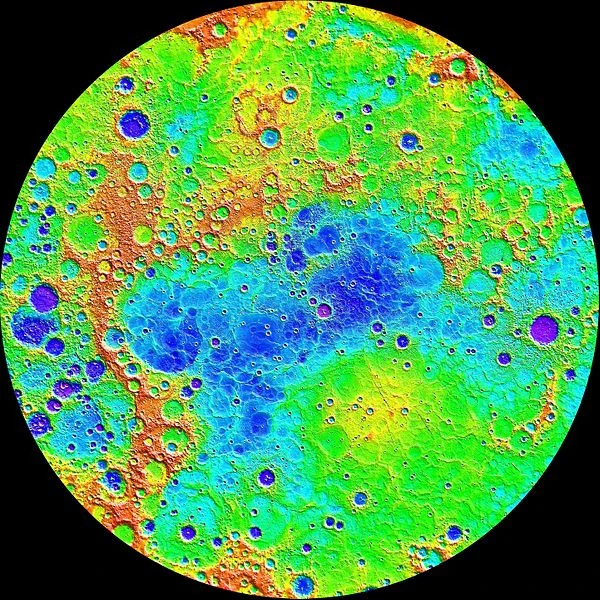
Image description: The seven scientific instruments on the MESSENGER spacecraft mapped the topography of Mercury's northern hemisphere in great detail during its more than four-year orbital mission. The view shows a color-coded relief map. The lowest regions are shown in purple and the highest regions in red. The difference in elevation between the lowest and highest regions shown here is about 10 kilometers!
Image source: NASA/Johns Hopkins University Applied Physics Laboratory/Carnegie Institution of Washington.
To date, only three probes have been sent to the planet closest to the Sun. These missions, although rare, have transformed our understanding of Mercury: its geology, magnetic field, and internal composition.
Launched in November 1973, Mariner 10 was the first probe to fly by Mercury. With three flybys in 1974 and 1975, it mapped about 45% of the planet's surface and revealed the existence of an unexpected magnetic field. It also provided data on the thin atmosphere (exosphere) and surface geology.
The MESSENGER mission (MErcury Surface, Space ENvironment, GEochemistry, and Ranging), launched in 2004, was the first to enter orbit around Mercury in 2011. It mapped the entire planet, analyzed its chemical composition, magnetic field, and internal structure, and confirmed the presence of water ice in the permanently shadowed polar regions. MESSENGER ended its mission by intentionally crashing onto the surface in 2015.
The BepiColombo mission, a collaboration between ESA and JAXA, was launched in October 2018. It will reach Mercury in December 2025. It consists of three modules: the Mercury Planetary Orbiter (MPO, ESA), the Mercury Magnetospheric Orbiter (MMO, JAXA, renamed Mio), and the Mercury Transfer Module (MTM) responsible for propulsion. BepiColombo will analyze Mercury's formation, composition, internal dynamics, and its interaction with the solar wind.
| Mission | Agency | Launch Year | Main Objectives | Major Results | Status |
|---|---|---|---|---|---|
| Mariner 10 | NASA | 1973 | Flybys of Mercury and Venus | First detailed images, detection of a global magnetic field | Mission completed (1975) |
| MESSENGER | NASA | 2004 | Complete mapping, geochemical and magnetic studies | 100% of the surface mapped, water ice detected at the poles | Mission completed (2015) |
| BepiColombo | ESA–JAXA | 2018 | Analysis of internal structure and magnetic field | Cruise phase, arrival expected in 2025 | Ongoing |
Future observations from BepiColombo should resolve the remaining uncertainties about Mercury's origin and thermal evolution. Combined with MESSENGER data, they will help better constrain planetary differentiation models and the magnetic history of the inner Solar System.